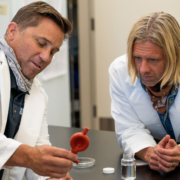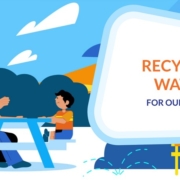You are now in California and the U.S. Media Coverage category.
Army Corps of Engineers Signs Off on Rindge Dam Removal
Removal of the 90-year-old Rindge Dam from Malibu Canyon—a long-anticipated, multi-million-dollar project—moved a crucial step closer to reality on Friday, Nov. 13, when the U.S. Army Corps of Engineers (USACE) announced the project’s report was signed and sent to congress for funding.
Region’s Water Quality Celebrated by Switchfoot Musician Jon Foreman
As part of its campaign to promote the quality of local water supplies, the San County Diego Water Authority and its 24 member agencies have partnered with Encinitas resident and Grammy-award winning musician Jon Foreman of Switchfoot to create a series of videos highlighting how tap water across the region meets or exceeds stringent state and federal standards.
The new videos are part of the Water Authority’s regional Trust the Tap outreach and education platform, which was launched in early 2020 to assure the public about the safety of water during the coronavirus pandemic. Related messages were shared in English and Spanish.
Region’s water quality celebrated
The videos highlight efforts to sample, test and treat water at three locations: Olivenhain Dam and Reservoir, the Twin Oaks Valley Water Treatment Plant and the Vista Irrigation District’s water quality lab. Foreman talks about sampling and treating with the Water Authority’s Chris Castaing and Javier Chavez, and he talks about testing with VID’s Distribution Supervisor Dean Farris.
The new videos are being shared on a variety of digital platforms, including website ads and social media (Twitter, Facebook, YouTube, and Instagram) in partnership with various radio stations. They also will be used as “pre-roll” video on streaming services.
Trust the Tap
Drinking water provided by the Water Authority and its 24 member agencies is treated by a combination of technologies – including sedimentation, filtration and disinfection – that chemically deactivate and physically remove bacteria, viruses and other contaminants.
The water quality outreach program is funded with a grant from the California Department of Water Resources.
This is the second time Foreman has partnered with the Water Authority. He interviewed Water Authority staff and toured various facilities for a series of videos in 2019 as part of the Brought to You by Water outreach and education program. The eight videos received more than 200,000 views on YouTube and were widely shared on social media.
New Water Recycling Videos on National Recycling Day
National Recycling Day on November 15 celebrates and promotes recycling practices to reduce waste and decrease energy demands, ultimately preventing pollution and fighting climate change. This year, the Water Authority partnered with the Southern California Water Coalition to promote water recycling.
National Recycling Day brings new video series
The Water Authority and other SCWC members, worked through the Coalition’s Recycled Water Task Force, along with other water districts and agencies in Southern California to create a new video series. The informative video series was created to educate the public on the use of recycled water in Southern California. The three-part video series shares a simple message – Water: Too Precious to Use Just Once.
The short videos explain the basics of water recycling and its importance as part of a diverse set of solutions employed by water agencies and local governments to stretch limited water resources. The series describes what water recycling is, how it is safe, and how it is used and will be used in the future.
“This new video series is the result of many water agencies and experts working in partnership to promote inclusive educational outreach about the safety and importance of water recycling in our communities,” said Lesley Dobalian, principal water resources specialist for the Water Authority and a member of the Recycled Water Task Force.
Water Too Precious to Use Just Once
Water recycling is the process of taking water that has already been used and treating it to levels safe for further beneficial use. Recycled water is highly regulated, and its use must comply with strict environmental and safety rules and requirements.
Thanks to advancements in water treatment technologies, reycled water is used to water landscapes, for commercial and industrial processes, and to recharge underground aquifers. Recycled water is also tapped for potable reuse through reservoir augmentation.
Water recycling is key to the region’s future
Recycled water is one more tool in the San Diego region’s water portfolio approach to provide a resilient water supply in the face of a changing climate. The Water Authority and its 24 member agencies have increased the region’s water supply reliability through diversified and innovative technologies like water recycling.
The Water Authority and its 24 member agencies have promoted the advancement of water recycling and potable reuse in San Diego County by developing educational resources such as potablereuse.sdcwa.org and obtaining outside funding from the Metropolitan Water District’s local resource program, and local, state, and federal grant and loan opportunities. Over the last year the Water Authority Board supported local potable reuse projects such as Pure Water San Diego, the East County Advanced Water Purification Program, and Pure Water Oceanside.
The video series was made possible through funding provided by the Los Angeles Department of Water and Power and the work of members of SCWC’s Water Recycling Task Force video subcommittee, comprised of representatives from the San Diego County Water Authority and other agencies throughout Southern California.
Seeing Clouds Clearly: Are They Cooling Us Down or Heating Us Up?
Though scientists know that clouds are critical to the climate system, their exact role is still uncertain. New studies are starting to fill in the knowledge gap.
The Rebirth of a Historic River
“My great uncle and my grandma and my great grandparents and, I’m sure, their great grandparents: they were all fishermen. That’s just what they did – they fished and it was out of necessity to support their families. And it’s because that’s what we’ve always done and we’ve never known another life,” says Amy Cordalis, the general counsel of the Yurok, and a member of California’s largest indigenous tribe.
It’s hard to overstate how important this livelihood has been to the Yurok people who have lived for millennia in rural Northern California. And yet this livelihood has been diminishing for decades after the Klamath River – which flows through the tribe’s territory – was dammed for hydroelectricity. But now, after years of painstaking negotiations, the fortunes of the Yurok could be set to change, with the largest dam removal project in US history given the green light.
Water Utility Hero of the Week, Matthew Carriveau, Otay Water District
This feature highlights water utility employees in the San Diego region working during the coronavirus pandemic to ensure a safe, reliable and plentiful water supply. The water industry is among the sectors that are classified as essential. Matthew Carriveau, Otay Water District Customer Pump Mechanic I, is the Water Utility Hero of the Week.
Will the West Figure Out How to Share Water?
In Crowley County, Colorado, sugar beets and alfalfa used to line the fields. It’s cantaloupes were famous.
But that all changed about three decades ago when most of the farmers sold their water rights to rapidly growing cities on the Front Range.
Coronavirus Lockdown Caused Dramatic Changes in Water Consumption, Research Finds
New research has found that the coronavirus lockdown led to dramatic changes in water consumption in England and Wales, and that some of these are likely to continue even after the pandemic.
Special Report: Restoration Projects at the Salton Sea
Nearly $47 million dollars have been secured in California’s state budget for the next year to begin mitigation efforts at the Salton Sea and the New River.
It’s a major win for a decades-long problem that has contributed to the environmental and health impacts in Imperial County.
Although, millions of dollars are being poured into helping improve the environmental health crisis Imperial County is facing, will it be enough and will residents see a change in their lifetime?




